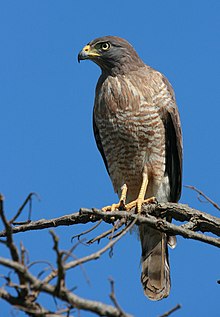Roadside hawk
| Roadside hawk | |
|---|---|

| |
| In Goiás, Brazil | |
| Scientific classification | |
| Domain: | Eukaryota |
| Kingdom: | Animalia |
| Phylum: | Chordata |
| Class: | Aves |
| Order: | Accipitriformes |
| Family: | Accipitridae |
| Subfamily: | Buteoninae |
| Genus: | Rupornis Kaup, 1844 |
| Species: | R. magnirostris
|
| Binomial name | |
| Rupornis magnirostris (Gmelin, JF, 1788)
| |

| |
| Synonyms | |
|
Buteo magnirostris | |



The roadside hawk (Rupornis magnirostris) is a relatively small
Taxonomy
The roadside hawk was
Twelve subspecies are recognised. Their distributions are as follow:[7][9]
- R. m. griseocauda (Ridgway, 1874) – Mexico (south from Colima, Nuevo León and Tamaulipas, except Yucatán and Tabasco) south to northwest Costa Rica and west Panama (Chiriquí).
- R. m. conspectus Peters, 1913 – southeast Mexico (Tabasco and Yucatán Peninsula) and north Belize
- R. m. gracilis Ridgway, 1885 – Cozumel and Isla Holbox, near Yucatán (Mexico)
- R. m. sinushonduri (Bond, 1936) – Guanaja and Roatán, off Honduras
- R. m. petulans (van Rossem, 1935) – southwest Costa Rica and Pacific slope of west Panama to Tuira River, and adjacent islands
- R. m. alius Peters & Griscom, 1929 – San José and San Miguel, in Pearl Islands (Gulf of Panama)
- R. m. magnirostris (nominate – Colombia south to west Ecuador, east to Venezuela and the Guianas, and south to Amazonian Brazil (Madeira Rivereast to Atlantic coast)
- R. m. occiduus Bangs, 1911 – east Peru, west Brazil (south of Amazon, west of Madeira River) and north Bolivia
- R. m. saturatus (P.L. Sclater & Salvin, 1876) – Bolivia, through Paraguay and southwest Brazil (southwest Mato Grosso) to west Argentina (south to La Rioja)
- R. m. nattereri (P.L. Sclater & Salvin, 1869) – northeast Brazil south to Bahia
- R. m. magniplumis (Bertoni, 1901) – south Brazil, north Argentina (Misiones) and adjacent Paraguay
- R. m. pucherani (J. Verreaux & E. Verreaux, 1855) – Uruguay and northeast Argentina (south to Buenos Aires Province)
Description
The roadside hawk is 31–41 cm (12–16 in) long and weighs 250–300 g (8.8–10.6 oz).[10] Males are about 20% smaller than females, but otherwise the sexes are similar.[11] In most subspecies, the lower breast and underparts are barred brown and white, and the tail has four or five grey bars. Twelve subspecies are usually recognised and there is significant plumage variation between these. Depending on the subspecies involved, the roadside hawk is mainly brown or grey. It is fairly common to observe a touch of rufous (i.e., a light reddish-brown) on the bird's wings, especially when seen in flight.[12] Its call is a very high-pitched piercing squeak. The eyes of adult roadside hawks are whitish or yellow. As suggested by its specific name, its beak is relatively large.[11]
The roadside hawk is the smallest hawk in the widespread genus Buteo;[13] although Ridgway's hawk and the white-rumped hawk are scarcely larger.[11] In flight, the relatively long tail and disproportionately short wings of the roadside hawk are distinctive. It frequently soars, but does not hover.[11]
Distribution and habitat
The roadside hawk is common throughout its range: from Mexico through
Behavior and ecology
Breeding
The bulky stick nest is lined with leaves and placed near the top of a tree. The clutch of one or two eggs is incubated for around 37 days, beginning after the first egg is laid.[16]
Food and feeding
The roadside hawk's diet consists mainly of
Hunting
Roadside hawks regularly hunt using the "
References
- . Retrieved 12 November 2021.
- South American Classification Committee (2011) Revise generic boundaries in the Buteo group.Accessed 16 June 2011
- ^ Gmelin, Johann Friedrich (1788). Systema naturae per regna tria naturae : secundum classes, ordines, genera, species, cum characteribus, differentiis, synonymis, locis (in Latin). Vol. 1, Part 1 (13th ed.). Lipsiae [Leipzig]: Georg. Emanuel. Beer. p. 282.
- ^ Buffon, Georges-Louis Leclerc de (1770). Histoire Naturelle des Oiseaux (in French). Vol. 1. Paris: De l'Imprimerie Royale. pp. 237–238.
- Daubenton, Louis-Jean-Marie (1765–1783). Planches Enluminées D'Histoire Naturelle. Vol. 5. Paris: De L'Imprimerie Royale. Plate 464.
- ^ Kaup, Johann Jakob (1844). Classification der Säugethiere und Vögel (in German). Darmstadt: Carl Wilhelm Leske. p. 120. Retrieved 28 December 2022 – via Biodiversity Heritage Library.
- ^ Rasmussen, Pamela, eds. (2023). "Hoatzin, New World vultures, Secretarybird, raptors". IOC World Bird List. 13.2. International Ornithologists' Union. Retrieved 22 December 2023.
- ISBN 978-1-4081-2501-4.
- ISBN 978-0-7136-8695-1.
- ^ "Roadside Hawk". oiseaux-birds.
- ^ ISBN 0-7136-8026-1.
- ISBN 85-85015-07-1.
- ^ Bierregaard, Richard O.; Boesman, Peter F.D.; Kirwan, Guy M. (4 March 2020). "Roadside Hawk Rupornis magnirostris". Birds of the World. Cornell Lab of Ornithology. Retrieved 15 September 2022.
- ^ BirdLife species factsheet for Buteo magnirostris
- ISBN 978-85-61368-00-5.
- ISBN 978-84-87334-15-3.
- .
- PMID 11188872.
- ISBN 978-0-8014-6611-3.[page needed]
- JSTOR 4164283.
External links
- "Roadside hawk media". Internet Bird Collection.
- Roadside Hawk Buteo magnirostris at Arthur Grosset's South American Birds
- Stamps[usurped] from Brazil, Nicaragua and Suriname at bird-stamps.org[usurped]
- Roadside hawk photo gallery at VIREO (Drexel University)
- Roadside hawk Photo at John Kormendy's Birds of Ecuador
- Roadside hawk species account at Neotropical Birds (Cornell Lab of Ornithology)
- Interactive range map of Rupornis magnirostris at IUCN Red List maps
- Audio recordings of Roadside hawk on Xeno-canto.


